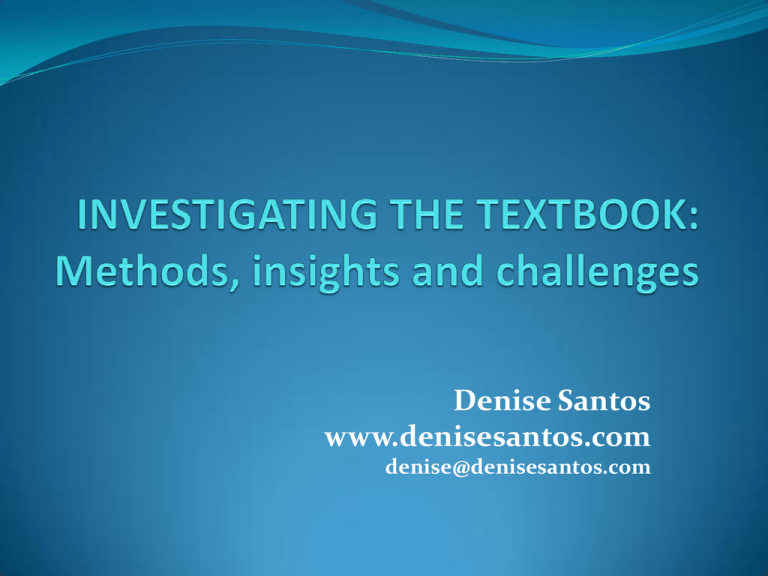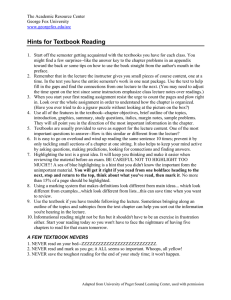Denise Santos www.denisesantos.com
advertisement

Denise Santos www.denisesantos.com denise@denisesantos.com The plan Overview of research into textbooks Approaches to textbook research Some findings from research Strengths/Weaknesses of different approaches From research to pedagogy Research into the textbook The history of materials Materials development The sociopolitics of textbooks Content analyses Textbooks in situated teaching-and-learning practices The history of materials „Textbooks have been used as source material for studies of how particular disciplines have developed within a subject, but extensive investigations are rare.‟ (Johnsen, 1993) The history of ELT (Howatt, 2004:161, from Ollendorff‟s New Method of Learning to Read, Write, and Speak a Language in Six Months, 1838) Barbara Peter Barbara Peter Barbara Peter Peter, where layde you your nightcap? I left it vpon the bedde. Are you ready? How should I be ready? You brought me a smock insteade of my shirt. I forgat myselfe: Holde, here is your shirt. Now you are a good wenche. (Howatt, 2004:23, from Jacques Bellot‟s Familiar Dialogues, 1586) The history of materials For more info, see Kelly, 1976 or Johnsen, 1993. The latter is also available on http://wwwbib.hive.no/tekster/pedtekst/kaleidoscope/index.html Also see the journal Paradigm for a number of studies in this area http://faculty.ed.uiuc.edu/westbury/Paradigm/ Materials development Guidelines for writers (Byrd, 1995; Tomlinson, 2003, Part B) Data collection (Fox, 1998; Carter et al, 1998) Design issues (Richards, 1993) Role of visuals (Choppin, 1992) Cultural issues (Adaskou et al 1990) The process of writing (Johnson, 2000; Atkinson, 2007) The sociopolitics of textbooks The textbook as cultural artefacts (Apple and Christian-Smith, 1991) The textbook as a commodity (Wortham, 1997) In ELT, a few scholars take up this perspective: (e.g. Gray, 2002; Pennycook, 1994:177-178; Richards, 1993) Some key issues Cultural differences: „the global export of English, English language teaching, and English textbooks frequently leads to situations of cultural conflict where the norms presented in the texts are in direct conflict with local social and cultural norms.‟ (Pennycook, 1994:176) The attempt to present „neutral language‟ (ibid: 177) The global coursebook (Gray, 2002) The de-skilling of the teacher (Richards, 1993) Content analyses Most frequent approach to textbook research May take up the form of surveys Typically, content analyses focus on (1)language (2) pedagogy (3) representations Surveys, some examples Business English (Arthur, 1983; Reed, 2007; Reed and Nolan, 2007) English for adults (Tomlinson et al 2001) Listening materials (Kellerman, 1992) Exam preparation (Scott, 2002) Focus on language Language presented in textbooks vs language used in the „real world‟ Business language (Williams, 1988) Phone conversations (Wong, 2002) Speech acts (Boxer and Pickering, 1995; Jiang 2005) Lexical chunks (Biber et al, 2004; Koprowski, 2005) Features of spoken grammar (Cullen & Kuo, 2007) Discourse features in interaction (Gilmore, 2004; Lam, forthcoming); Order of presentation vs frequency of use (Mindt, 1996); Koprowski, 2005) Focus on pedagogy Emphasis on cooperation? (Jacobs and Ball 1996) Recitation/authentic activities? (Santos 2002) Recitation Series C Series B Series A Authentic 0% 20% 40% 60% 80% 100% Focus on representations and/or conceptualisations of… Gender (Jones et al, 1997; Carrell and Korwitz, 1994) Ecological issues (Jacobs and Goatly, 2000) Social harmony (Hayes, 2002) English varieties (Chelliah, 2001) The target culture and its people (Kramsch, 1987, 1988; Santos, 2002) Insights? Challenges? Historical, sociopolitical, pedagogical, linguistic insights Multiple perspectives complement each other What do we look at? What method(s)? From a research perspective: importance of a clear focus, related questions and coherent methodology Textbooks in situated teachingand-learning practices Prescriptive approach (Early, 1991) Learning how to make sense of the world through textbooks‟ (Baker and Freebody, 1989; Maybin and Moss, 1993) Teachers‟ talk around text (Sunderland, 2000) „our data shows cases of the “traditional” focus of texts being endorsed, “progressive” texts being undermined, those parts of texts that can be seen as containing “traditional biases” being passed over, and talk about gender issues within texts being characterized by “gender blindness”.’ Textbook appropriation: a makingmeaning process 1 How participants describe / talk about the textbook 2 How participants describe / talk about the event in which the textbook participates 3 How participants open and close the event in which the textbook participates 4 How participants rearticulate the text 19 Theoretical assumption Language as a mediating tool (Vygotsky , 1978): to engage in talk is „to engage in a social mode of thinking‟.(Mercer, 1994:95) Readings are constructed, contested and negotiated through talk at the point where texts are first calculated and reshaped again when they are jointly recalled. Talk also helps to construct the text’s legitimate audience and the reader’s position within it. (Maybin and Moss, 1993:138) The teacher as interpreter THINK LOOK ANSWER (From Littlejohn and Hicks, 1996a:9) 21 T: S: T: T: maybe you you could share . er . if you look at this picture here on page nine . look . . and think a little bit about it .look at this . ((shows students the page)) look at this picture here . and see how many words can you write words? yes . how many words can you write? okay ? you look at this picture . How many words can you understand […] yes . the student’s book . .look at this one . can you share this? you look at the picture and see how many words can you understand . okay? . so this is for you […] T: look at this picture here . look . there are many words here . there are many things look there are many words here . right? I would like to you to write on this paper the words that you can really understand […] T: look at the picture . look at the picture . see the words that you can understand . there are some words that you can understand . the ones that you understand the ones that you 22 understand . okay? you write down on a piece of paper T: S: T: T: maybe you you could share . er . if you look at this picture here on page nine . look . . and think a little bit about it .look at this . ((mostra pagina aos alunos)) look at this picture here . and see how many words can you write words? yes . how many words can you write? okay ? you look at this picture . How many words can you understand […] yes . the student’s book . .look at this one . can you share this? you look at the picture and see how many words can you understand . okay? . so this is for you […] T: T: look at this picture here . look . there are many words here . there are many things look there are many words here . right? I would like to you to write on this paper the words that you can really understand […] look at the picture . look at the picture . see the words that you can understand . there are some words that you can understand . the ones that you understand the ones that you 23 understand . okay? you write down on a piece of paper T: S: T: T: T: maybe you you could share . er . if you look at this picture here on page nine . look . . and think a little bit about it .look at this . ((mostra pagina aos alunos)) look at this picture here . and see how many words can you write words? yes . how many words can you write? okay ? you look at this picture . How many words can you understand […] yes . the student’s book . .look at this one . can you share this? you look at the picture and see how many words can you understand . okay? . so this is for you […] T: look at this picture here . look . there are many words here . there are many things look there are many words here . right? I would like to you to write on this paper the words that you can really understand […] look at the picture . look at the picture . see the words that you can understand . there are some words that you can understand . the ones that you understand the ones that you understand . okay? you write down on a piece of paper 24 Insights? Preferential (socially endorsed) interpretations and „codes of behaviour‟ Naturalised meanings Joint negotiation of these meanings Knowledge representation and construction Role of language in these semiotic processes Not too much on textbook content 25 What can we learn from textbook research? Different perspectives, different (a lot of!) insights Awareness of strenghts/weaknesses of different approaches Attention to students’ voices needed Not an ‘attractive’ topic? Critical uses of the textbook (Santos, 2007; Santos and Silva, 2008; Smith et al, 2009; Wallace, 1992) What do you think?

